Contents
Port wine stains
Port-wine stain also called nevus flammeus, is a type of birthmark that got its name because it looks like maroon (light pink to a dark red color) wine was spilled or splashed on the skin. A port-wine stain is caused by a malformation of tiny blood vessels called capillaries. Other small birthmarks that are related to port-wine stains are sometimes called salmon patches, which may also be called angel kisses (when they are on the baby’s face) and stork bites (when they are on the back of the baby’s neck). Like port-wine stains, salmon patches start as flat, pink or red patches; the difference between these birthmarks is that salmon patches tend to fade in the first year of life while port-wine stains become darker and grow along with the baby.
In the past, port-wine stains and salmon patches were considered to be variations of the same kind of birthmark, but now it is now known that port-wine stains are truly malformations of capillaries and will never improve on their own, while salmon patches are temporary dilatations (expansions) of capillaries that do typically improve on their own.
Port wine stains usually occur on the face and neck and less often on the trunk and limbs. Port wine stains do not usually cause any symptoms but they can produce long-term psychological trauma and problems with self-image and self-esteem if they are present on visible areas such as the face. A lot can be done to reduce their psychological impact, including the treatments discussed below. Cosmetic camouflage can also be helpful as can be advice from patient support groups.
Later in life port wine stains can become deeper red or purple in color and become raised or lumpy and more difficult to cover with makeup. The raised areas can bleed easily if they are scratched.
Port wine stains of the eyelid area and upper jaw sometimes lead to increased pressure within the eye (glaucoma). Rarely patients with facial port wine stains are prone to seizures and require further assessment and investigation. An extensive port wine stain of a limb may be associated with an increase in growth of that limb (Klippel-Trenaunay syndrome).
Port-wine stains are always present at birth, though they may change in appearance as the baby gets older and grows. Approximately 1 in 1,000 babies is born with a port-wine stain. There is no known association within families (genetic tendency) at this time. Although port-wine stains have no sex predilection, they are much less common in Asians and African Americans. Due to their similarity, it is important to note that salmon patches are much more common, and about 7 in 10 babies will have one of these.
These birthmarks are noncancerous, but port-wine stains are sometimes associated with other syndromes involving the brain and development. Klippel-Trenaunay syndrome involves malformations of the veins (venous malformations), port-wine stains (capillary malformations), and excessive growth of the soft tissues. Additionally, some individuals with Klippel-Trenaunay syndrome have one limb that is longer and larger than the other limb. The syndrome is most frequently diagnosed in infancy or early childhood.
Though port-wine stain birthmark often starts out looking pink at birth, port-wine stains tend to become darker (usually reddish-purple or dark red) as kids grow.
Uncomplicated port-wine stains do not usually cause any physical symptoms. However, they can upset the quality of life of the affected individual and their family.
Port-wine stains won’t go away on their own, but they can be treated. Laser therapies can make many port-wine stains much less noticeable.
Figure 1. Port wine stain face
Figure 2. Port wine stain birthmark
The skin of the port-wine stain should behave just like the skin on the rest of the baby, although the port-wine stain may darken and expand as the baby grows; if the skin bleeds or develops cracks or other problems, contact your child’s doctor for further advice.
Can a Port Wine stain be cured?
Unfortunately, a Port Wine stain does not go away on its own and usually cannot be cured, although it may become far less noticeable after treatment with Pulsed Dye Laser.
Port-wine stain causes
The cause of Port Wine stains is not known. However, Port Wine stains are thought to develop in areas of skin lacking the small nerves that control the constriction of small blood vessels. The blood vessels stay open, causing a permanent blush in the affected area of skin. Port wine stains occur in approximately 3 per 1000 births, affecting males and females and all racial groups equally.
It is proposed that port-wine stains develop due to irregularities in neural development (ie, axonal degeneration) and genetic mutations that may be familial or sporadic 1). Studies have shown that biopsies of port-wine stains specimen have a greater vessel-to-nerve ratio with overall decreased nerve density relative to normal skin 2). It has been proposed that irregular blood flow in port-wine stains leads to chronic ischemia and results in further axonal injury and degeneration. Furthermore, the lack of neural modulation of blood flow results in worsening of ectatic vessels 3). Port-wine stains typically occur in regions that are normally innervated by certain nerve branches, such as the trigeminal nerve, and show significantly decreased nerve fiber density compared to unaffected skin 4). They present as well-demarcated, solid, pink, red or purple patches and can affect any part of the body; however, they frequently effect the head and neck area, particularly in a V1 and V2 dermatomal distribution. Dilated capillaries and post-capillary venules in associated port-wine stains lesions results in increased hemoglobin content in the overlying skin, which causes the deeply red to purple pigmented skin. Capillary malformations do not proliferate and thus do not grow, but instead they demonstrate chronic vascular dilation with possible gradual darkening and thickening over many years with or without treatment 5). The deep reddish purple to violaceous color created by the hemoglobin pigment appears like Port-Wine, which is where they inherited their name. It is important to differentiate port-wine stains from other vascular tumors that may present during infancy or early childhood since the diagnosis may change treatment options and overall patient outcome.
Acquired Port Wine stains may appear without known cause, as part of an illness or in previously inflamed or injured skin.
Is a Port Wine stain hereditary?
Port Wine stains do not often run in families; however, they are relatively common, affecting about 1 in 300 babies, equally in both sexes. Port Wine stains are not contagious or cancerous.
Port-wine stain signs and symptoms
A port-wine stain is almost always present at birth. Port-wine stains are never painful or itchy. It is sometimes difficult to tell the difference between a port-wine stain and other birthmarks, such as a salmon patch or a hemangioma, but it can be diagnosed by your child’s doctor, based on its appearance.
Most port-wine stains affect the face, but they may involve any area of the skin.
The appearance of a port-wine stain tends to change during life. A flat faint red, purple or pink mark is usually seen at birth, which may become temporarily darker when the baby cries, has a temperature or is teething. Although the port-wine stain usually does not get any larger, it does grow in proportion with the child.
Port Wine stains often turn darker red or purple in adults and the skin becomes thicker. Lumps can form (a cobblestone-like appearance), which may bleed readily. The lip or nose, if involved, may in some people become slightly swollen.
Eczema (dermatitis) can develop over a port-wine stain, which may then be itchy or sore.
A port-wine stain may rarely be part of more widespread abnormalities, some of which are listed below:
- Port-wine stain is occasionally associated with congenital glaucoma. A port-wine stain in the skin around the eye, may be associated with increased pressure in the eye (glaucoma). A referral to an eye-specialist may be required.
- Sturge-Weber syndrome (intracranial angiomas). Rarely a port-wine stain on the upper face can be linked to abnormalities within the brain called Sturge-Weber syndrome. This can be investigated by the neurology specialists with scans.
- Klippel-Trenaunay syndrome (limb hypertrophy). Klippel-Trenaunay syndrome occurs when there is enlargement of the limb affected by the port wine stain, which may also develop enlarged deeper varicose-type veins.
- A port-wine stain on the central back overlying the spine can be linked to an underlying spine defect called spina bifida (Latin for ‘split spine’).
Port-wine stain distribution:
- The face is the most commonly affected site
- The nape of the neck and upper trunk are other common sites, although any part of the body can be affected
Port-wine stain morphology:
- Pink to deep red / purple patches
- Often unilateral with a distinct cut off
- Lesions tend to persist, darken and thicken with age
Sturge-Weber syndrome
- The usual cutaneous finding is a unilateral port-wine stain, involving roughly the areas served by the ophthalmic and maxillary divisions of the trigeminal nerve
- Epilepsy occurs in up to 90% of cases – once seizures start neurological deterioration with mental retardation can be rapid
- Patients without seizures fare much better
- Glaucoma and other eye complications arise in 50-60% of all cases
- Early referral is indicated
Figure 3. Port-wine stain with Sturge-Weber syndrome
Klippel-Trenaunay syndrome
Klippel-Trenaunay syndrome is characterized by three features:
- a capillary malformation (port‐wine stain) of the skin associated with
- a soft‐tissue and bone overgrowth and hypertrophy in combination with
- varicose veins, with or without deep venous and lymphatic abnormalities.
Klippel-Trenaunay syndrome can be diagnosed if only two of the three features are present
The capillary/venular malformation (port‐wine stain) affects 98% of Klippel-Trenaunay syndrome and is usually present at birth. The abnormal veins affect 72% of cases, and as with this case may not affect typical sites; some of the varicosities are only visible once the child is walking. Limb hypertrophy affects 67% of affected individuals
The skin changes can be seen as follows:
- Most commonly involve the lower limbs, followed by the arms, the trunk and rarely the head and neck
- The capillary/venular malformation (port‐wine stain) is pink-reddish with linear borders, may darken with age to purple. 10% are nodular
- The changes seldom cross the midline.
Figure 4. Port-wine stain with Klippel-Trenaunay syndrome
Port-wine stain diagnosis
A dermatologist can diagnose a Port Wine stain by taking a history about the skin changes and looking at the appearance of the skin.
Port-wine stain treatment
Your child’s doctor will likely advise you to wait and see how the patch develops; if a port-wine stain is very large or on the baby’s face, however, he/she will likely recommend that your baby have further testing to make sure that there are no associated syndromes that might involve the brain or the baby’s development and will also recommend that you see a dermatologist in order to begin planning treatment. There is no treatment necessary for a port-wine stain, but some people are bothered by the appearance – particularly if it occurs on the face – and will choose to begin treatment earlier rather than later. The treatment usually involves laser therapy of the skin.
Laser treatment
Various lasers are in use for treatment of Port Wine stains. Early treatment is possibly more effective, as the baby’s skin is thinner and the Port Wine Stain relatively small. However, even after successful early treatment, the remaining areas of port wine stain may darken again later in life.
The Pulsed Dye Laser is most commonly used. It emits a beam of special light, which reacts with the red color in blood. Adults do not usually require an anesthetic, apart from cooling the skin. Children may need a general anesthetic. The treatment causes immediate dark bruising and the skin is more sensitive to rubbing. Other possible temporary side effects include blistering and crusting. Scarring is rare. A course of laser treatment is usually required, with a few months between repeated treatments. The aim of treatment is to make the port wine stain paler, as it is often not possible to make it fade completely. If the port wine stain has developed bleeding areas, these can be successfully treated by laser.
Depending on the size and site of the birthmark, up to 10 treatment sessions may be required at intervals of approximately 8 weeks. Port wine stains on the limbs respond less well than those on the face. Treatments given early in life, before the birthmark becomes thickened, are more successful than those used later on.
In addition to the Pulsed Dye Laser, several other lasers and light-based treatments are in use, and research is on-going for treatment-resistant port wine stains.
Cosmetic camouflage
Skin camouflage can be very useful. Camouflage is a type of special, water resistant make-up matched to the color of the normal skin. You can get a prescription for a special type of camouflage make-up that covers up the birthmark.
Port-wine stains with the Sturge-Weber syndrome
- Facial lesions need early referral for the following reasons:
- To consider the possibility of the Sturge-Weber syndrome
- The cosmetic impact of such lesions can be substantial – referral to a dermatology department with laser facilities is appropriate
- Lesions on or near the eyelid can be associated with glaucoma – where the face is affected both above and below the eye the risk of glaucoma is particularly high. 40% of the cases of glaucoma arise in infancy, but glaucoma can also arise in adults and those at risk need early assessment and long-term follow up with an ophthalmologist
Port-wine stains with Klippel-Trenaunay syndrome
- Effective treatment can be given to the capillary malformation using pulsed dye laser
- Given the possible limb changes, difficulties with varicose veins and other potential complications (including genitourinary hemorrhage, gastrointestinal hemorrhage, hemothorax) a multidisciplinary approach is required
References [ + ]









